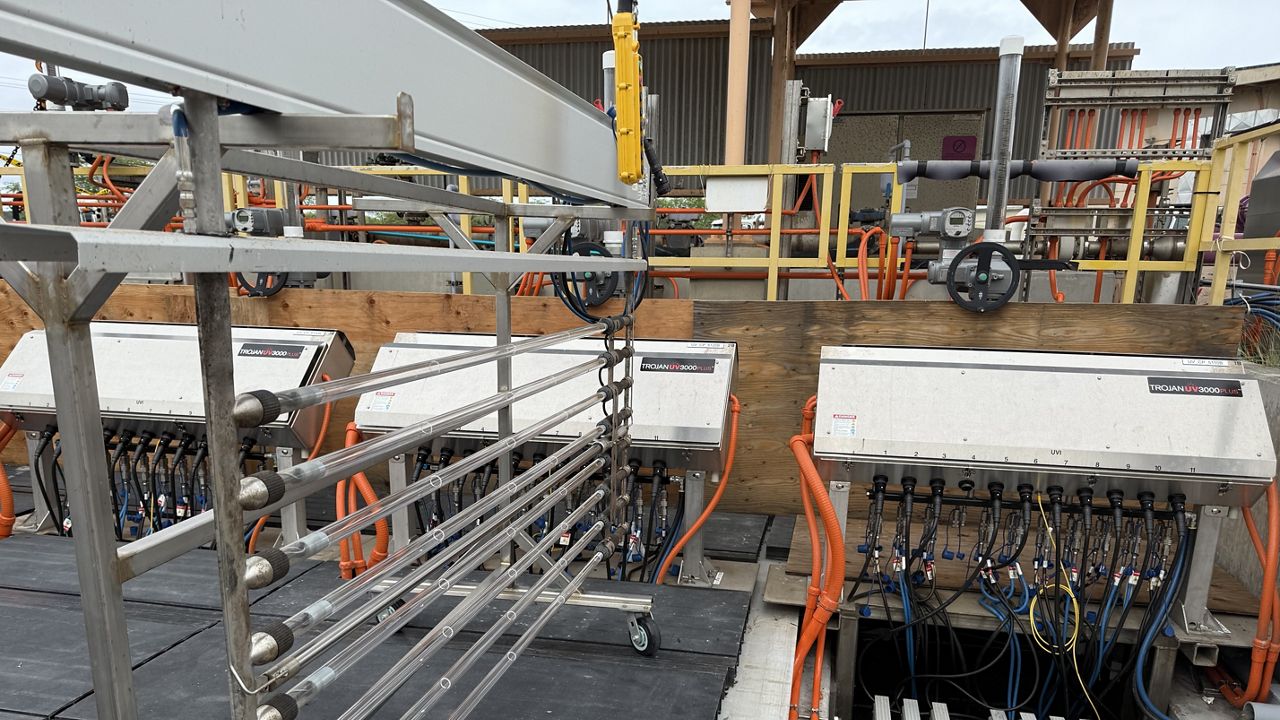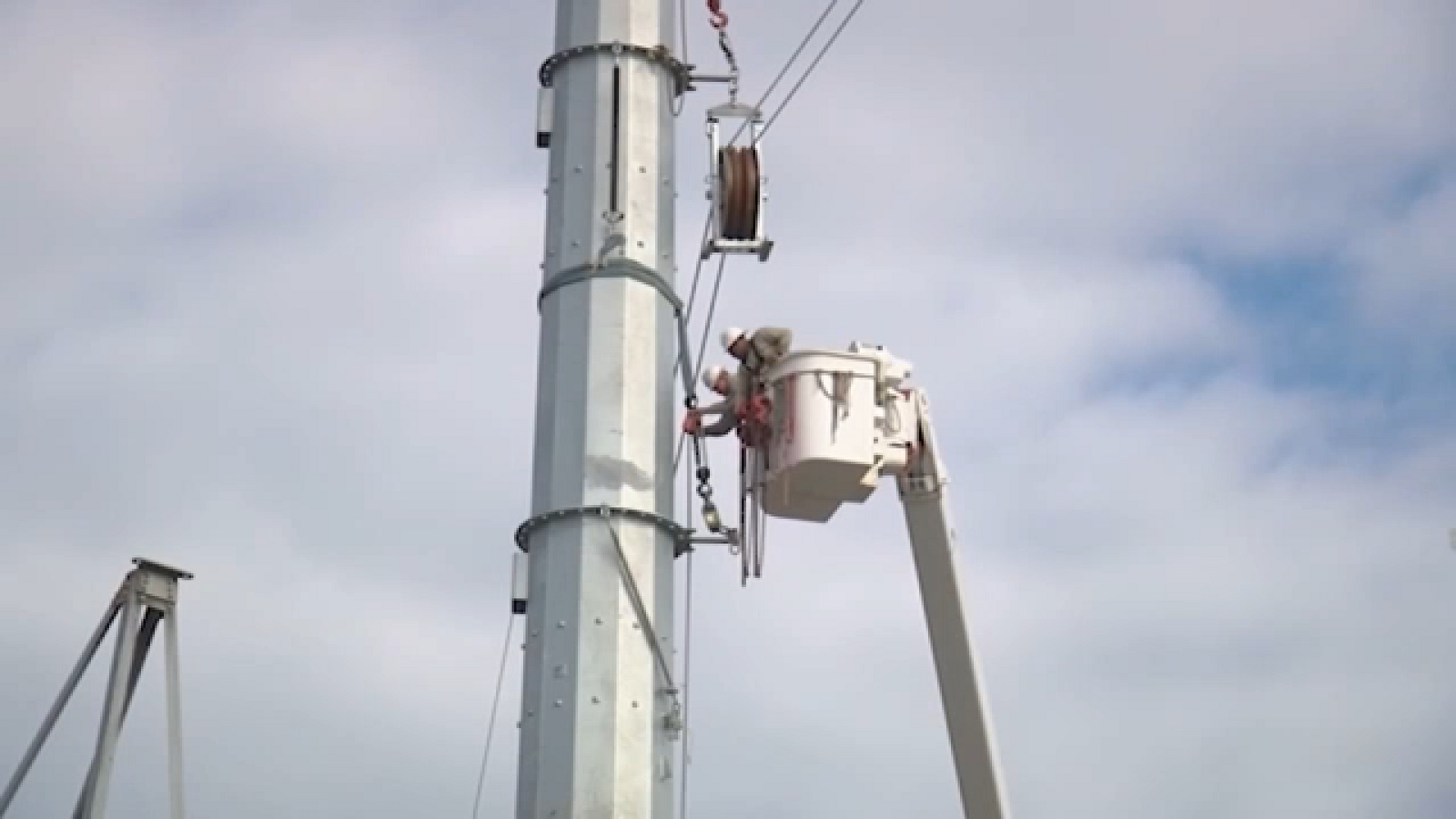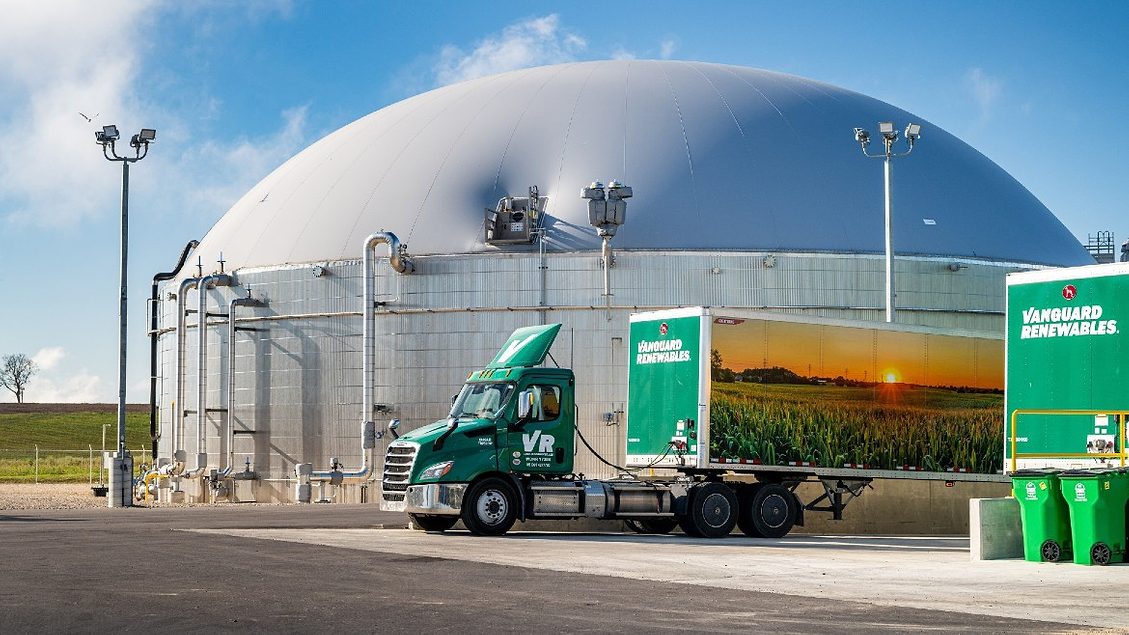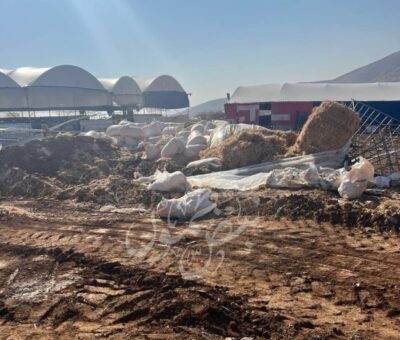It’s Time to Engineer the Sky
In February 2023, two men conducted an audacious experiment by releasing sulfur dioxide (SO2) into the stratosphere using a balloon, as part of solar geoengineering efforts. Solar geoengineering aims to cool the Earth by mimicking the cooling effects of volcanic eruptions. As global warming continues, the debate over these unconventional solutions is intensifying, with supporters seeing it as a potential tool to mitigate climate change and critics concerned about its potentially disruptive consequences, including altered weather patterns, ozone depletion, and geopolitical conflicts. Scientific uncertainty and public debate surround these proposals, with some advocating for cautious research and governance to understand the potential risks and benefits.

On the crisp afternoon of February 12, 2023, two men parked a Winnebago by a field outside Reno, Nev. They lit a portable grill and barbecued a fist-sized mound of yellow powdered sulfur, creating a steady stream of colorless sulfur dioxide (SO2) gas. Rotten-egg fumes permeated the air as they used a shop vac to pump the gas into a balloon about the diameter of a beach umbrella. Then they added enough helium to the balloon to take it aloft, attached a camera and GPS sensor, and released it into the sky. They tracked the balloon for the next several hours as it rose into the stratosphere and drifted far to the southwest, crossing over the Sierra Nevada Mountains before popping and releasing its gaseous contents. The contraption plummeted into a cow pasture near Stockton, Calif.
The balloon released only a few grams of SO2, but the act was a brazen demonstration of something long considered taboo—injecting gases into the stratosphere to try to slow global warming. Once released, SO2 reacts with water vapor to form droplets that become suspended in the air—a type of aerosol—and act as tiny mirrors, reflecting incoming sunlight back to space. Luke Iseman and Andrew Song, founders of solar geoengineering company Make Sunsets, had sold “cooling credits” to companies and individuals; a $10 purchase would fund the release of a gram of SO2, which they said would offset the warming effects of a metric ton of atmospheric carbon dioxide for a year. They had planned a launch in Mexico but switched to the U.S. after the Mexican government forbade them.
Many people recoil at the notion of solar geoengineering, or solar radiation management (SRM), as it's often called. The idea that humans should try to fix the atmosphere they've messed up by messing with it some more seems fraught with peril—an act of Faustian arrogance certain to backfire. But as it becomes clear that humans are unlikely to reduce emissions quickly enough to keep global warming below 1.5 degrees Celsius, some scientists say SRM might be less scary than allowing warming to continue unabated. Proposals for cooling the planet are becoming more concrete even as the debate over them grows increasingly rancorous.
SRM replicates a natural phenomenon created by large volcanic eruptions. When Mount Pinatubo erupted in the Philippines in 1991, it blasted 20 million tons of SO2 into the stratosphere, creating an “aerosol parasol” that cooled the planet by about 0.5 degree C over the next year or so before the droplets settled back to Earth. Studies suggest that if SRM were deployed at sufficient scale—maybe one quarter of a Pinatubo eruption every year, enough to block 1 or 2 percent of sunlight—it could slow warming and even cool the planet a bit. Its effects would be felt within months, and it would cost only a few billion dollars annually. In comparison, transitioning away from fossil fuels is expected to take decades, and the CO2 emitted until then could make warming worse. Using machines to remove billions of tons of CO2 from the skies, a process called direct-air capture, could slow warming but would be fighting itself—the machines might increase the world's energy consumption by up to 25 percent, potentially creating more greenhouse gas emissions. Because SRM could produce effects quickly, it has political appeal. It's “the only thing political leaders can do that would have a discernible influence on temperature within their term in office,” says Ken Caldeira, a climate scientist emeritus at the Carnegie Institution for Science, who is also a senior scientist at Breakthrough Energy, an organization founded by Bill Gates.
Caldeira and others say SRM should be pursued with extreme caution—if at all. It could noticeably whiten our blue sky. It could weaken the stratospheric ozone layer that protects us and Earth's biosphere from ultraviolet radiation. It might change weather patterns and move the monsoons that water crops for billions of people. And it wouldn't do anything to remedy other CO2-related problems such as ocean acidification, which is harming the ability of corals, shellfish and some plankton to form skeletons and shells.
Critics also say that the very idea of an escape hatch such as SRM could undermine support for reducing greenhouse gas emissions. Like a prescription drug, if SRM were used responsibly—temporarily and in small doses—it could be beneficial, easing what is likely to be a dangerously hot century or two and buying humanity some extra time to transition to renewable energy. But it also has potential for abuse. At higher doses it could increasingly distort the climate, altering weather patterns in ways that pit nation against nation, possibly leading to war.
For all these reasons, more than 400 scientists have signed an open letter urging governments to adopt a worldwide ban on SRM experiments. But other scientists are proceeding, if reluctantly. “All the scientists I know who are working on this—none of them want to be working on it,” says Alan Robock, a climatologist at Rutgers University. Robock, who previously showed the world how a nuclear winter could shroud Earth, studies SRM out of a sense of obligation. “If somebody's tempted to do this in the future,” he says, they “should know what the consequences would be.”
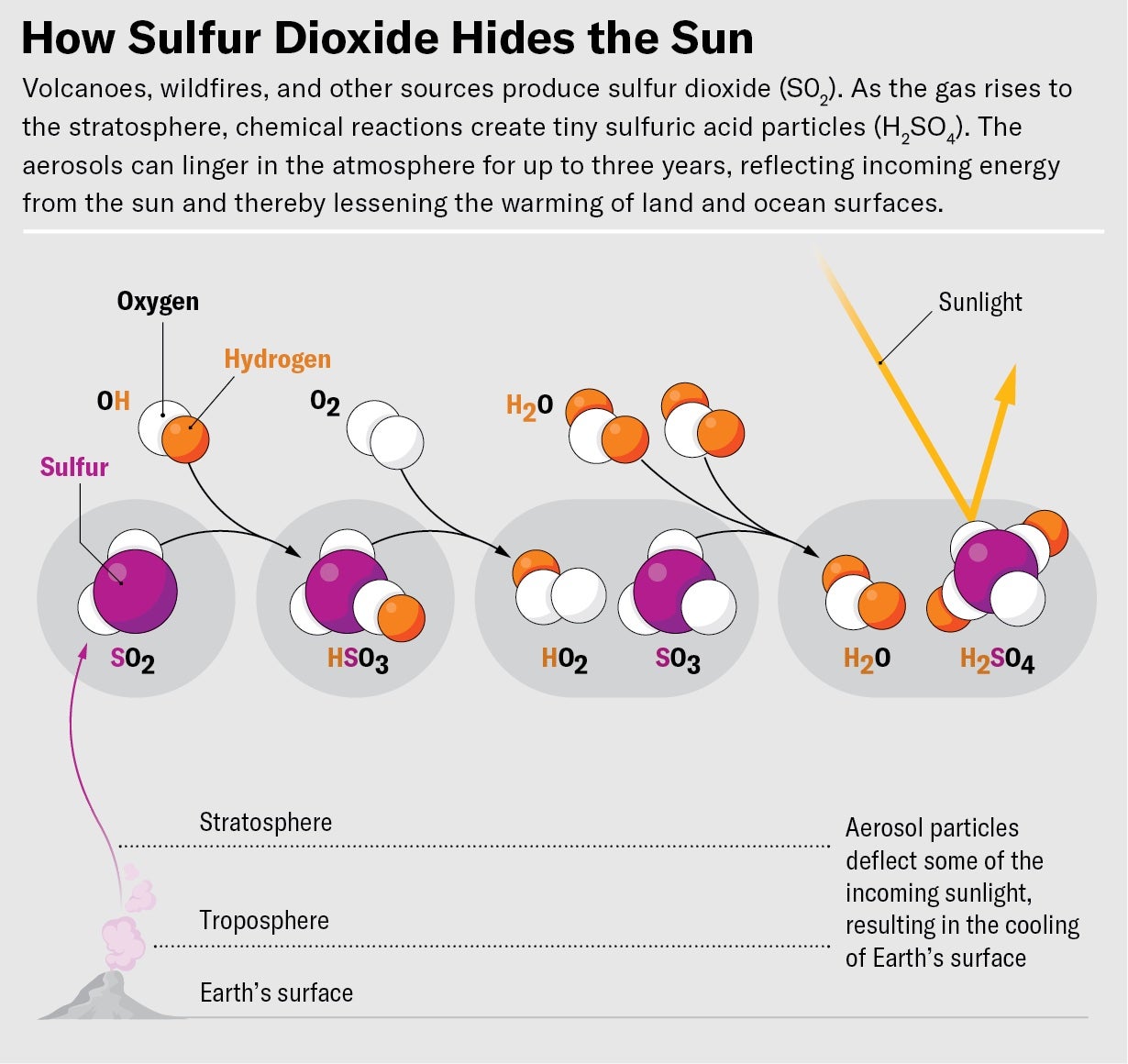
Experts who support trials note that unabated warming is just as consequential. In a recent report, the World Meteorological Organization estimated a 66 percent chance that by 2027 the world's average annual temperature will briefly exceed 1.5 degrees C above preindustrial levels—a dangerous threshold beyond which extreme damage to the environment occurs. On February 27, 2023, a few days after Iseman and Song sent barbecued sulfur into the sky, 110 climate scientists, including climate change pioneer James Hansen, published a different open letter urging government support for SRM research. The following day the United Nations called for international regulations that could pave the way for experimentation. And in June the Biden administration released a report outlining what an SRM research program could look like.
Even if SRM reduced average temperatures, it wouldn't reset the climate to its preindustrial state, says David Keith, head of climate systems engineering at the University of Chicago, who has studied the idea for over two decades. But it could lessen the hurt coming for us.
The idea that humans can change the planet's atmosphere for their own purposes has a long history. In 1962 the U.S. military started Project Stormfury, an attempt to weaken hurricanes by seeding their clouds with silver iodide particles. From 1967 to 1972 the U.S. Air Force dabbled in weather-control warfare over Vietnam and Laos; in a highly classified effort called Operation Popeye, several aircraft flew daily missions to spray lead and silver iodide powder into monsoon clouds. The goal was to increase rainfall, which would muddy up the Ho Chi Minh Trail, a network of coarse roads, interrupting Vietcong supply lines.
Almost as soon as scientists understood that rising CO2 could warm the planet, some of them proposed making Earth more reflective to counter the effect. In 1965 scientists reported to President Lyndon B. Johnson that warming caused by rising CO2 could be addressed by spreading reflective particles across the oceans. In 1974 Russian climatologist Mikhail Budyko suggested that injecting SO2 into the stratosphere via aircraft or rockets could reflect sunlight. This technology, he wrote, “should be developed without delay.” Perhaps surprisingly, these proposals did not include the idea of reducing emissions.
The idea of planet-scale engineering didn't gain much traction over the next two decades. When Lowell Wood, an engineer at Lawrence Livermore National Laboratory in California and an early proponent of the “Star Wars” missile defense system, stood up at the 1998 Aspen Global Change Institute conference to tout the cooling effects of stratospheric aerosols, the reception was chilly. “Ken [Caldeira] and I stood in the back room and almost shouted at him,” Keith recalls. He “was completely overstating how well it would work.” Their skepticism was based on simple logic: CO2, by absorbing long-wave radiation rising from Earth, warms the planet uniformly from the equator to the poles year-round, day and night—whereas sunlight warms the planet mainly at lower latitudes, with stronger effects during the summer and the daytime. They thought dimming the sun would cool the planet unevenly, Caldeira says. “You get much more cooling at the equator,” more cooling during summer, and less at the poles.
Caldeira returned to Livermore, where he also worked, and persuaded Govindasamy Bala, a climate scientist there, to test the idea with a sophisticated computer model. The model diminished incoming sunlight by 1.7 percent—enough to counteract the warming effects of CO2 levels that were double what they had been in preindustrial years. “It worked a hell of a lot better than we expected,” Caldeira says. The results, published in 2000, indicated that SRM would still cool the tropics a little more than the poles and make a bigger difference in summer than in winter, but overall the cooling would be far more uniform globally than Bala, Caldeira and Keith had thought.
A consortium of researchers that included Robock later replicated Bala's results across a dozen different climate models. But their 2013 findings revealed a red flag. As concentrations of stratospheric aerosols increased, the cooling grew less uniform, and the climate became more distorted. If stratospheric aerosols were used to offset the average warming caused by a quadrupling of CO2 levels, the tropics would be 0.3 degree C cooler than in preindustrial times, but the polar regions would still be 0.8 degree C warmer. Permafrost and sea ice might not fully recover, meaning we would fail to reverse some of climate change's most damaging effects.
Bala discovered another worrisome detail: stratospheric aerosols might reduce rain and snowfall. Researchers knew that more warming increases the evaporation of water, leading to more precipitation, so it stood to reason that the reverse would also be true. But Bala found that dimming the sun could reduce rainfall more than it reduces temperature. That's because blocking sunlight, while leaving CO2 high, slightly reduces the tendency of water vapor to form clouds. Simulations across the 12 models predicted that if SRM was used to fully counteract the warming of quadrupled CO2, some parts of the tropics would receive 5 to 7 percent less annual rainfall compared with preindustrial times, potentially harming crops or tropical forests.
This and other observations led Keith and his colleagues to suggest a lower-dose approach to SRM in which stratospheric aerosol injections would be used temporarily to reduce the effects of climate change, buying nations time to cut greenhouse gas emissions and draw down (or “capture”) CO2 from the atmosphere.
Keith sketched out this scenario in a 2018 paper co-authored with climate scientists Douglas MacMartin of Cornell University and Katharine Ricke of the Scripps Institution of Oceanography. They envisioned a world in which greenhouse gas emissions are cut and carbon capture is deployed so that CO2 peaks in 2070 at just over twice its preindustrial concentration before starting to slowly decline. This would cause roughly three degrees C of warming—a lot. To limit warming to 1.5 degrees C, stratospheric aerosol injections would be initiated around 2030 and slowly ramped up. Injections would peak in 2070 and be slowly reduced before being halted about two centuries later, when CO2 levels had fallen sufficiently. Peter Irvine, a climate scientist at University College London, ran this scenario through 13 models. The results, published in 2019 in Nature Climate Change, showed that during the period of peak CO2 concentrations, stratospheric aerosols would reduce warming and lessen precipitation extremes (including droughts and deluges) for 99.6 percent of the planet's ice-free land surface.
Other SRM methods might eventually be developed to even out the cooling. Marine-cloud brightening would involve spraying sea salt 1,000 meters into the air to seed the formation of cloud droplets, increasing the reflectivity of low-lying clouds over some parts of the ocean. In cirrus-cloud thinning, particles of silver iodide would be sprayed into clouds at altitudes of 4,500 to 9,000 meters, enlarging ice crystals in those clouds so they fell out of the sky. The remaining, thinner cirrus clouds would allow more long-wave radiation emanating from Earth to escape to space. Both methods would have more localized effects than injecting SO2 would, so it might be possible to deploy them selectively to balance the effects of stratospheric aerosols, says Sarah Doherty, an atmospheric scientist at the University of Washington who studies marine-cloud brightening. “It may turn out that doing a little bit of each [method] would allow you to maximize benefits and minimize risks,” she says.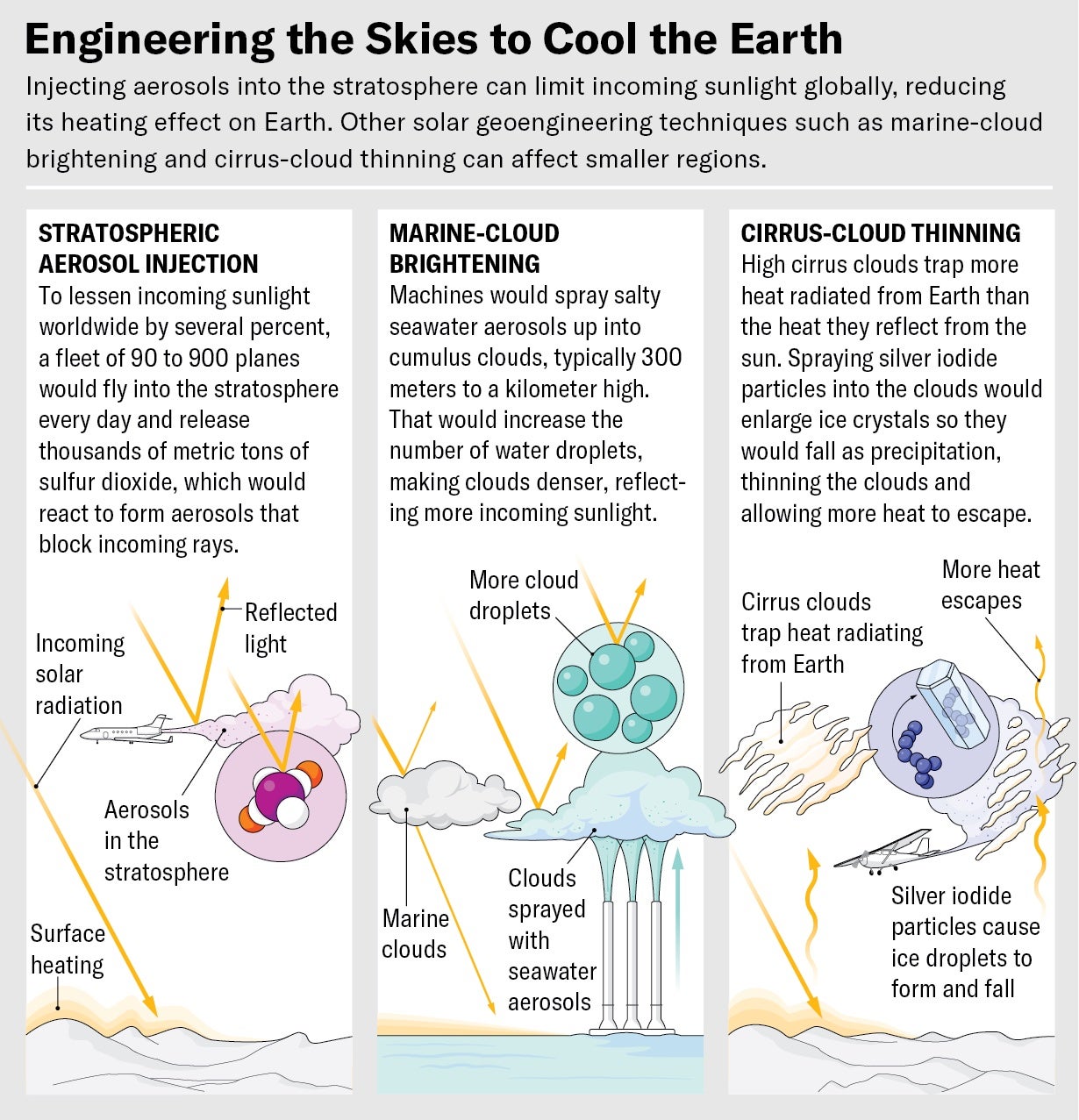
Stratospheric aerosol injection is the best-studied approach to solar geoengineering and the closest to deployment. But making it work would require overcoming major challenges. The atmosphere 20 kilometers up is neither Earth-like nor spacelike. At that altitude, roughly twice as high as commercial jets fly, the air pressure is just 5 percent of what we enjoy on the ground—low enough to spontaneously boil the fluids out of a person's mouth and lungs. Lift against an airplane's wing is minuscule. Only a handful of research planes worldwide can operate in air this thin. The best known is NASA's ER-2, a derivative of the U-2 spy plane with a tiny fuselage and gangling, oversized wings. It is piloted by a single human who must wear a full pressure suit, like an astronaut. It carries less than two metric tons of cargo.
ER-2s have flown more than 4,500 research missions in the past 50 years, sampling aerosols and gases in the stratosphere. They have refined our understanding of how ozone is destroyed. They have flown through volcanic eruption plumes. And they have helped to create the scientific foundation on which SRM is based. But these high-altitude albatrosses will never carry tons and tons of SO2.
Planes capable of that job could be developed with largely existing technologies, says Wake Smith, a former aviation-industry executive and a climate researcher at the Yale School of the Environment. Since 2017 Smith has refined the concept of a six-engine plane based loosely on the B-47 Stratojet, a high-altitude U.S. Air Force craft designed in the 1940s to deliver nuclear bombs deep inside Soviet territory. Smith's Stratospheric Aerosol Injection Lofter would heft 15.7 tons of aerosol to a height of 20 kilometers every flight. Depending on how much SRM is desired, Smith envisions 90 to 900 planes flying missions every day by 2100. Building the first plane might take seven to 10 years; building a fleet could take 20 years.
Smith estimates that once the planes are built, the program might cost $18 billion annually per degree C of cooling. That's a small amount compared with the hundreds of billions of dollars a year it would take to remove billions of tons of CO2 from the atmosphere. But SRM has a much higher chance than carbon removal of causing nightmarish unintended consequences. Stratospheric injections by any country would affect the entire globe. Done wrong, they could disrupt weather patterns and the lives of billions of people.
A large fraction of humanity depends on a belt of thunderstorms and rain called the Intertropical Convergence Zone. The zone straddles the equator around the planet and shifts as far as 2,500 kilometers north or south with the seasons, pulled always toward the warmer hemisphere. Its movement spawns the monsoons that arrive each summer in India, Southeast Asia, Africa, and other regions, dropping more than 45,000 cubic kilometers of water annually, sustaining crops that feed 1.5 billion people in South Asia alone.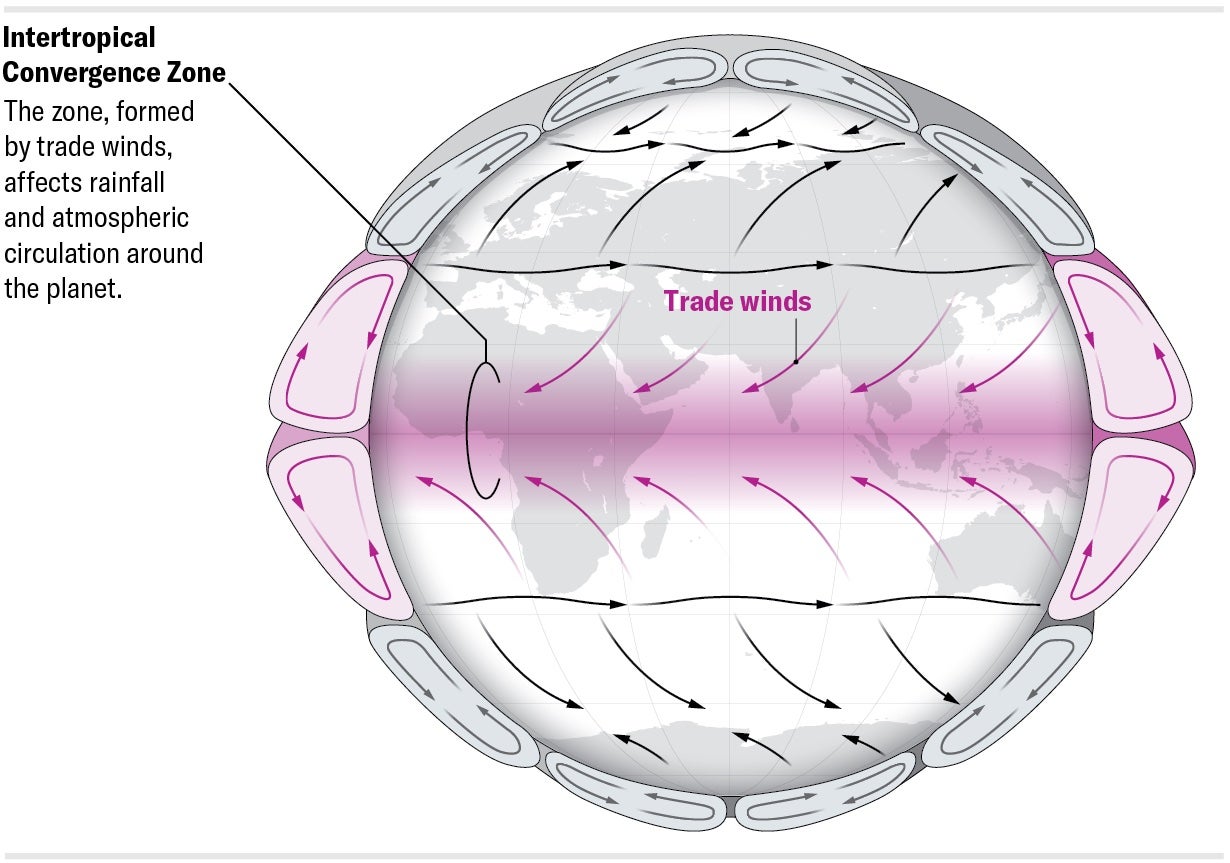
In 2008 Bala, the scientist at Livermore who first tested SRM in a model, moved to the Indian Institute of Science in Bangalore and began to study how human activities might affect that country's monsoons. His simulations showed that if aerosols were injected at the equator, they would spread over the Northern and Southern Hemispheres, with little impact on monsoon patterns. But some people have proposed a polar strategy in which aerosols would be injected at the high northern latitudes to slow rapid Arctic warming without overcooling the tropics. This well-intentioned proposal would have a “huge impact” on Indian monsoons, Bala says. His latest calculations, published in 2022, suggest that if injections sufficient to cool the planet by 1.5 degrees C were done at 30 degrees north, the monsoon band could shift southward by roughly 150 kilometers, reducing India's summer rainfall by up to 29 percent and threatening crops.
Bala's study demonstrates that stratospheric aerosol injection is never local; it inevitably has far-reaching effects. In 2021 Ricke modeled aerosol injections over the Indian Ocean meant to increase rainfall and reverse a long-standing drought in the semiarid Sahel region of North Africa. The intervention just shifted the droughts to a different set of nations, in East Africa. Another modeling study, in 2022, suggests that stratospheric aerosols could shift the burden of malaria from highland areas in East Africa to lowland areas in South Asia and sub-Saharan Africa. Some regions where the parasite currently thrives would become too cool for it; other places, currently too hot, would cool enough for it to take hold. These vast shifts in risk could harm “countries that are often outside the room when we're talking about geoengineering,” says Christopher Trisos, an ecologist at the University of Cape Town in South Africa, who co-led the malaria study.
For all these reasons, Ricke says, SRM research is in “a very dangerous place.” Most studies assume that it will be done in an internationally coordinated way, but she says modelers should also study scenarios in which injection is done haphazardly. The relatively low cost of SRM means many countries could afford it. “I think it's just inevitable that someone's going to try to do this,” Ricke says.
Imagine a nightmare scenario in which individual countries, responding to heat waves, fires or floods, begin injecting aerosols unilaterally. Imagine that Russia initiates high-latitude injections to cool its Arctic regions. This action would push the monsoon belt southward, depriving India, Thailand and Vietnam of critical rain. It might also shift torrential rainfall farther south in Brazil, triggering floods. If these countries respond by beginning their own injections to lessen rainfall, a dangerous escalation could play out in the stratosphere. One country might even destroy another country's SRM aircraft, leading to a sudden rebound of warming and perhaps war.
People who support SRM point to studies showing that it could affordably reduce climate extremes. Critics point to studies showing the havoc it could cause. But the scientists who try to forecast effects will admit that most of these predictions contain huge uncertainties. The uncertainty begins with the models being used. Although SRM has shown consistent results in more than a dozen climate models, that's not because widely varied approaches are converging on the same answers. It's because “we have too many people running climate models that are similar,” Keith says. If the assumptions underlying one model are wrong, then all the models might be wrong.
Models used to predict the effects of SRM contain dozens of variables representing physical parameters ranging from the chemical reactivity of aerosol droplets to their size. Tiny variations in the variables can have wide-ranging consequences. For example, a droplet that is one to two microns across (smaller than a red blood cell) should reflect sunlight most efficiently because its diameter is close to the wavelength of most incoming solar radiation. Larger droplets aren't just less effective—they could actually cause warming by absorbing long-wave radiation rising from Earth's surface that would otherwise escape to space. Another crucial variable is the rate at which droplets cause chemical reactions that destroy ozone. When researchers try to predict the effects of stratospheric injection, they plug in their best estimates for such variables. The problem is that most studies use similar estimates. “The big question,” Keith says, “is, Are we wrong?”
To address this uncertainty, Keith recommends running large “ensembles”—hundreds of different versions of the same model in which different combinations of numbers are plugged in. Scientists have done only a few such studies of SRM effects. Keith hopes to oversee more ensemble work at the University of Chicago. The range of climate outcomes this research produces could then be plugged into models that predict how SRM could affect crop yields, forest fires, storms, or the spread of malaria and other diseases.
Still, no matter how many large ensembles scientists run, it's impossible to know how SRM will work until it's been tested in the real world—and tested at a much larger scale than two guys releasing a balloon outside Reno. In 2011 Keith and Caldeira published an analysis suggesting that a meaningful stratospheric-injection trial would take a decade. Several hundred thousand tons of SO2 would have to be injected every year—enough, theoretically, to reverse 10 percent of the warming caused by a doubling of preindustrial CO2 levels. The minimum viable experiment, in other words, “would be indistinguishable from a deployment,” Caldeira says.
Smaller experiments could reduce uncertainties in the models. Scientists could get a better understanding of injection equipment, for example, by building it and using it to release anywhere from a few kilograms to a few metric tons of SO2 into the stratosphere. That work could reveal whether ejected droplets remain the same size while aloft, details about chemical reactions, and what effects they have on ozone. In fact, scientists have been doing studies like this since the 1960s, releasing tracers such as zinc sulfide powder or sulfur hexafluoride gas into the stratosphere to study air currents.
But when the subject of inquiry is SRM, barriers to even small experiments become extreme. In early 2021 Keith and Frank Keutsch, an atmospheric chemist at Harvard, were planning the first SRM field trial. The Stratospheric Controlled Perturbation Experiment (SCoPEx) was designed to mimic a trail of aerosol released by a stratospheric aircraft. A self-propelled balloon would ascend 20 kilometers, release half a kilogram of sulfate into the wake of its propeller, then fly back through the aerosol trail to monitor how it evolved. The experiment would release only 0.3 percent of the amount emitted by a commercial transatlantic flight. The researchers planned for the first launch, slated for June 2021 in northern Sweden, to merely test the equipment without releasing any gas. It never happened.
In February 2021 the Sámi Council, a group representing Indigenous reindeer herders in the region, protested to the Swedish government that they had not been notified of the test occurring in their airspace. They, along with Greenpeace Sweden and several other environmental groups, persuaded the government to cancel it. The protests were never about the environmental impact of the test, MacMartin says. What happened, he says, is that “the entire conversation about ‘Oh, my God, do we even want to go down this path?’ got stapled onto that experiment.”
Many SRM opponents would like to ban experiments outright. Yet some scientists are continuing the research because they believe it's the responsible thing to do. “The people who should be advocating for experiments the most are the people who think that bad stuff would happen,” Caldeira says. “The most valuable experiment that somebody could do now is one [showing] that there would be really horrible consequences.” And if SRM is going to be studied and perhaps even rolled out, it's better to start sooner and more gradually, so the downsides can be understood. Ironically, SRM might have more public support if it were delayed until climate impacts become extreme, but at that point it would have to be done urgently and rapidly. “There's a real mismatch between what is politically and environmentally risky,” Caldeira says.
Even small experiments will need the legitimacy of being funded and regulated by government, Kelly Wanser says. She is executive director of Silver Lining, a nonprofit organization that is encouraging the National Science Foundation and other government bodies to establish funding for SRM research and set up rules defining how and when experiments can be performed. Scientists would like that kind of governance, Ricke says. After all, it has long existed for other sensitive science areas, such as medical studies in humans, and has improved the quality of that research. The goal would be an international body, similar to the Intergovernmental Panel on Climate Change, that would set research priorities while considering the interests of rich and poor nations. Absent that structure, legitimate science is not progressing, Ricke says, and “rogue activities are starting to emerge.”
Two months after the Reno balloon release, on April 10, Iseman and Song visited the Berkeley Marina in California to launch three more stratospheric balloons, funded by $2,840 of cooling credits purchased by customers. “A 747 emits this amount in a couple of minutes,” Iseman said as he held high the first balloon in his right hand, with San Francisco Bay shimmering in the background and a camera crew filming. Then he let it go. A few days later the two men attended an Earth Day event in San Francisco, where they helped children launch their own small balloons, coated with chalk dust, which could aerosolize. “Our goal,” Iseman said, “is to make 1,000 new geoengineers.”
What is Your Reaction?
 Like
1
Like
1
 Dislike
0
Dislike
0
 Love
0
Love
0
 Funny
0
Funny
0
 Angry
0
Angry
0
 Sad
0
Sad
0
 Wow
0
Wow
0




























